What Happened to Fashion in the 1960s?
Style History- The Look of the 1960's
Written past- Kalyani Kala, Manner Business organisation Management, ISDI. Faculty- Belinda Bawa

The transition of fashion from one decade to some other played itself like a vocal on repeat. The ruling tenure of trends and brands was going to come across a shortening of age and all of this happened in the 1960'due south. A decade of opposites yet the one that hosted them both. This means that the 1960's was a decade where both- sophisticated designs inspired from the 50's and rather bold and revolting designs of the new generation were equally famous. This makes the 1960'due south one of the nigh decade for fashion. This was for the first time that fashion was driven around the youth market and featured a wide number of diversified trends.
The fashion trends in the decade bankrupt many fashion traditions by mirroring socials movements that were making headlines in that period. The ideology of designing for simply mature and aristocracy members was allow down as the influence and need to cater to the teenage and immature adult market place was increasingly important. More radically innovative fashion styles, similar little girl androgynous looks for women, swept away the ruling likes of the sophisticated sweater girls of the sixties.

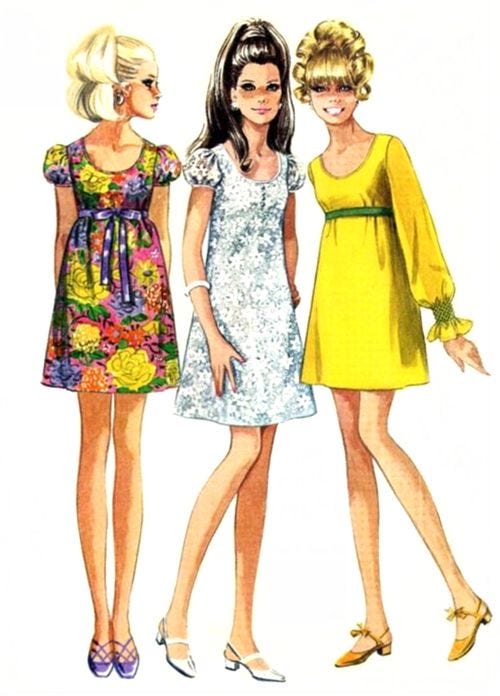
1960s manner was bi-polar in only nearly every way. Brilliant, swirling colors. Psychedelic, tie-dye shirts and long hair and beards. Adult female wore unbelievably brusk skirts and men wore tunics and capes. The foray into fantasy would not have been believed past people just a decade earlier.
It's nearly like the 1950s bottled everyone upward so much that the tardily 1960s exploded like an old pressure level cooker. Women were showing more skin than ever before. Wouldn't be hard to believe that expose was discussion coined in the 60's. For the first time in the 19th Century, London, not Paris, was the center of the fashion earth. The British Invasion didn't terminate with The Beatles. It swept into all parts of life, especially clothing. Even though this time period saw the maximum experimentation in terms of colors, and sizes of habiliment, information technology wasn't seen as a revolutionary menstruation as everything revolved around tweaking the existing.
Trends of decades are basically named and written most on the basis of the famous looks that people opted for and designers provided. Few of the about famous elements and looks from the lx's include:
- The typical daytime look — consisting of a bulbous chapeau over a high bouffant coiffure, silhouettes with deep armholes an broad sleeves, and a rounded jacket that tapered in at the hem.
- For evenings it was the slender look. Long-waisted dresses, often with an overblouse, replaced the fitted waistline and full brim. The long dress of sequins or crystal beads had replaced the bouffant clothes.
- Contemporary compages and sculpture were the most prevalent inspirations for fashion designers in 1960 which could exist seen in bloused, bias-cut clothes, long straight overblouse and sashed tunics, short skirts, closely plumbing equipment hats and exaggerated makeup (peculiarly red lips) and brusk hair.
- Culottes, divided skirts and trim trouser skirts were introduced for travel, street clothing and evenings at abode. Skirts got a little bit shorter in 1960. While worn with depression-heeled shoes it placed more attention on the leg. Collarless coats, suits and dresses created a long-necked effect. Some dresses had draped cowl backs to intensify the elongated await.
- Plaids of all sizes and colors were heavily favored. Abstract and expressionist art were big influences on printed silk designs. Wools were in style, but had to lightweight. Glaze and suit woolens were usually loosely woven and sometimes as porous equally lace.
- Deep, darker colors were the rage in 1960. They especially covered the spectrum between purple, red and green. Colors like similar grape, plum, wine cherry-red, garnet and olive green. In contrast, neon bright pinkish was also a very popular color for those looking to make a argument.
- Furs and hats maintained their popularity, as did fur and seal coats. Evenings turbans of tulle swirled loosely around the head not only gained high manner acceptance, but were sold in every hat shop.
- From Brigitte Bardot'south beehive to Mary Quant's geometric prints, every 1960s way icon contributed their own signature style to the decade (a theme that continued well into 1970s fashion and beyond). It was the era of the daughter group, the gamine supermodel and the original IT-girls, who are still inspiring this generation's Alexa Chung et al.
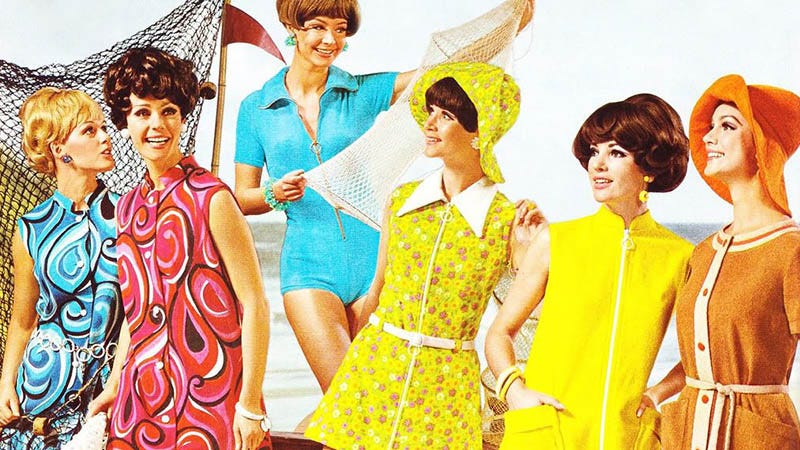
The 1960's is marked an era of a number of various trends. It was a decade that broke many fashion traditions/rules , mirroring many social movements during this fourth dimension menstruation.
By this time, the trends of fashion started getting influenced from small pockets of young people as that sector received large media coverage and publicity. This in plough, heavily influenced both- Haute Couture of the elite designers and the mass-market manufacturers. Example- the mini skirt, culottes, become-go boots, and more experimental fashions, less frequently seen on the street, such every bit box-shaped PVC dresses and other PVC clothes.
The changing time and influence on fashion was driving to an increase in demand and production of pales, black whites, neon, bold, tie-die, etc. These colors were blended in geometric patterns in materials like cotton, wool, in Crochet technique. Silhouettes besides largely dominated this era as they were used as- tubular silhouettes, straight lines, waistless shifts, bell sleeves, trapeze dresses, pencils skirts, mini skirts, hippi (relaxed) article of clothing etc.
The major influencers of style were still the United Kingdom and America and the trends in men's fashion in these places could be seen in the slim fitting single breasted continental style suits and skinny ties. The fashion icons for this era were Jacqueline Kennedy, Sophia Loren, Jean Shrimpton, Twiggy, Veruschka and for men Sean Connery as James Bond majorly influenced the fashion. Though women'due south style was largely influenced by Jackie Kennedy from the get-go of the decade till the stop. From Modest to "in that location is no such affair every bit too short," everything revolved around freeing the listen of women and handing over the power in their hands.
The jazz culture was gradually moving towards Rock & Roll and Pop culture and thus saw the rise of bands like The Beatles. There was also a significant ascension in Teenage Subculture such as Modern, Rude boy, Black panther, Skinhead and more.
The main highlights of this fourth dimension frame were the trends set up by famous designers who too surprisingly became more know because of the models. The fan post-obit of models made for a marketplace for the designers. Some of these trends include:
- Colored tights-
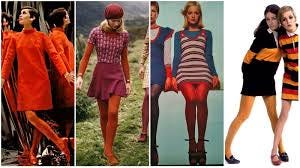
They were besides popular in white, blackness and in purple, fishnet, herringbone or lace. The very idea behind making these tights is rather discriminatory equally they were made to cover upwardly ugly knees and didn't cause garter gaps similar sheer stockings did.One time pantyhose were perfected they were the savior of women's legs anywhere. They camouflaged hair, bumps, bruises, and broad kneecaps. Even peel tone tights were thick and night. To go blank legged in the '60s was still as well immodest.
2. 1960s Pant Suits-

There was an array of ruckus and confusion over the new pantsuit equally information technology battled equally with "the not as well brusk mini skirts." Information technology was a look straight copied from men's suits but tailored down to feminine proportions. Some work offices and establishments forbade women to wear pantsuits. At that place was a confusion over whether they were an insult to femininity or empowerment for women (and that information technology disrespected men). Women read all nearly them in the magazines and flocked at stores in masses to buy the pantsuit. Surely a talk of the town!
3. Shift Dresses-

Shift dresses were casual wearable for home, running errands or going to the beach. They were non function friendly. Since they were also short, they weren't considered part friendly. 1960s dresses became shorter and shorter. How brusque a woman's dress was became a sign of how confident she was barring the necessity of having groovy legs. Hem length was straight proportional to how women felt about their ain sexual liberation. Short skirts were non meant to concenter men for the sake of sexual interest, but instead were a manner to attract attention and so that a WOMAN could be the one to make up one's mind if his attention was wanted. Sexual power through style. The jumper apparel was a Mary Quant invention that captured the youthful, playful, side of 1960s fashion. That style immediately made a 20-year-one-time look 10, a welcome alter from the'50s mature way. Big bows, big round collars, pastels, and polka dots were all apparel details that made women look like little girls' dolls. The more innocent the ameliorate.
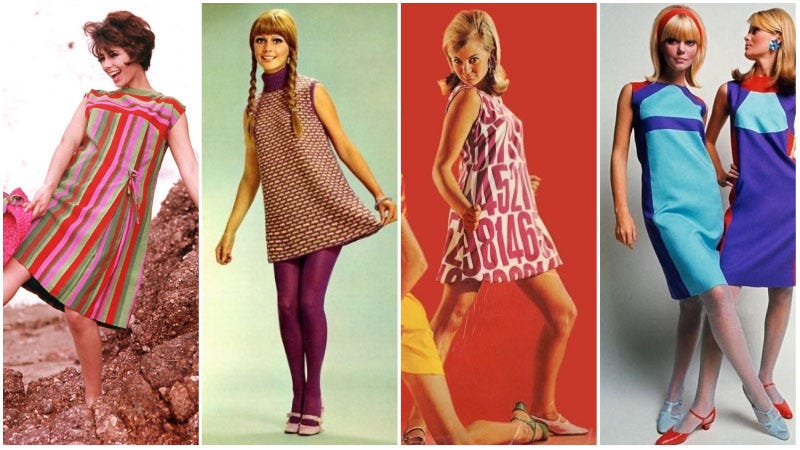
4. THE GO GO BOOTS-
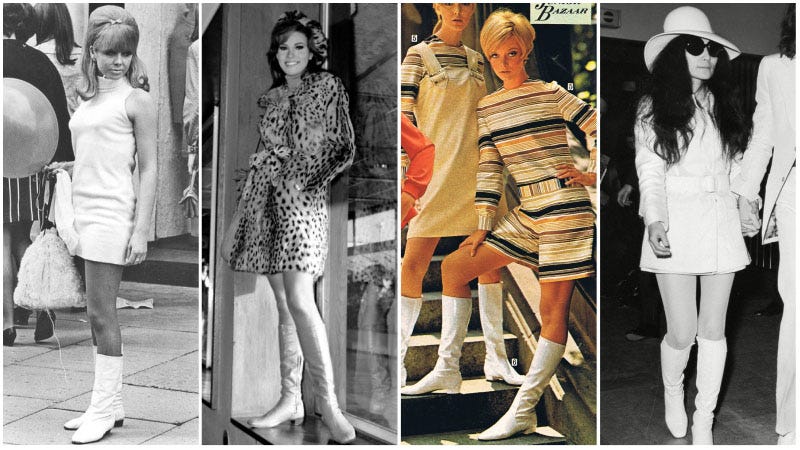
Go-get boots are an iconic '60s footwear style. This wasn't the first time that white shoes came back to the racks. Traditionally white, these shoes were introduced in the middle of the decade staring a classic boot await with depression heels and high up till right under the knees. However, over fourth dimension, the term has grown to include a variety of like styles, including knee-high versions, other colours and kitten-heeled designs.
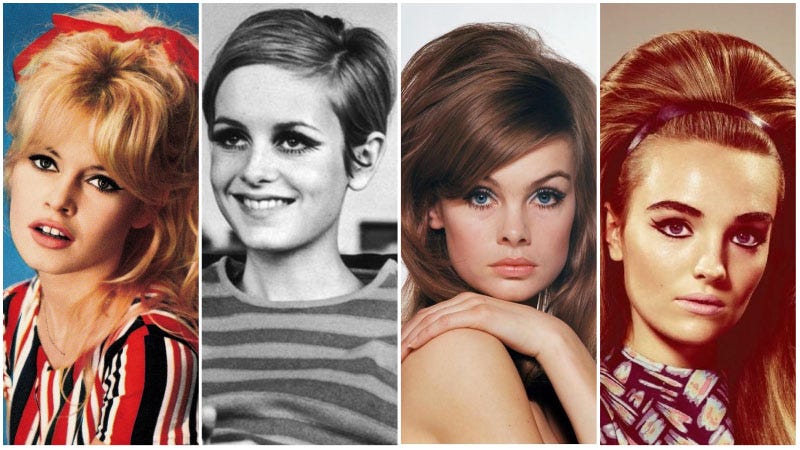
HAIRSTYLES- are the kickoff accessory to an outfit. A complimenting hairstyle tin void the need to have jewelry on. The most famous and trending hairstyles of this period were:
WOMEN-
- Beehive Hairdos were famous in the early part of the decade.
- Very brusk styles popularized by Twiggy and Mia Farrow.
- Very long straight style equally popularized by the hippies in the tardily 1960s.
- The chin-length contour cut and the pageboy were also popular.
- The pillbox hatwas stylish, due well-nigh entirely to the influence of Jacqueline Kennedy, who was a mode-setter throughout the decade.
- During the mid and late 60s, women'due south hair styles became very big and used a large quantity of pilus spray, every bit parodied in the musical Hairspray.
- Heavy book made faces appear smaller and more doll-similar. Hair length rose from shoulder to mentum and cropped above the ears as the decade progressed, only to come crashing down again in the '70s.
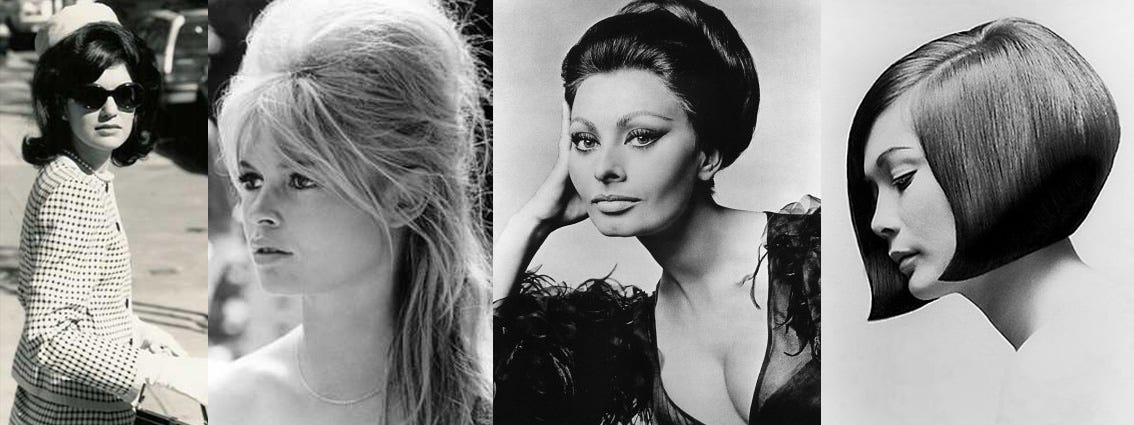
MEN-
- For professional men born before 1940, the side parted short back and sides was the norm in the Great britain, Europe and America from the early on 60s until the cease of the decade.
- Black men usually buzzed their pilus short or wore styles like the conk, artificially straightened with chemicals.
- Blue collar white men, particularly former military personnel, often wore buzzcuts and apartment tops during the summer.
- During the early to mid 60s, rebellious Irish gaelic-American, Italian-Americanand Hispanicteens influenced by the greaser subculture oftentimes wore ducktails, pompadours and quiffs.
- Due to the influence of mod bands similar the Beatles or the Rolling Stones, mop-tophairstyles were most popular for white and Hispanicmen during the mid 60s.
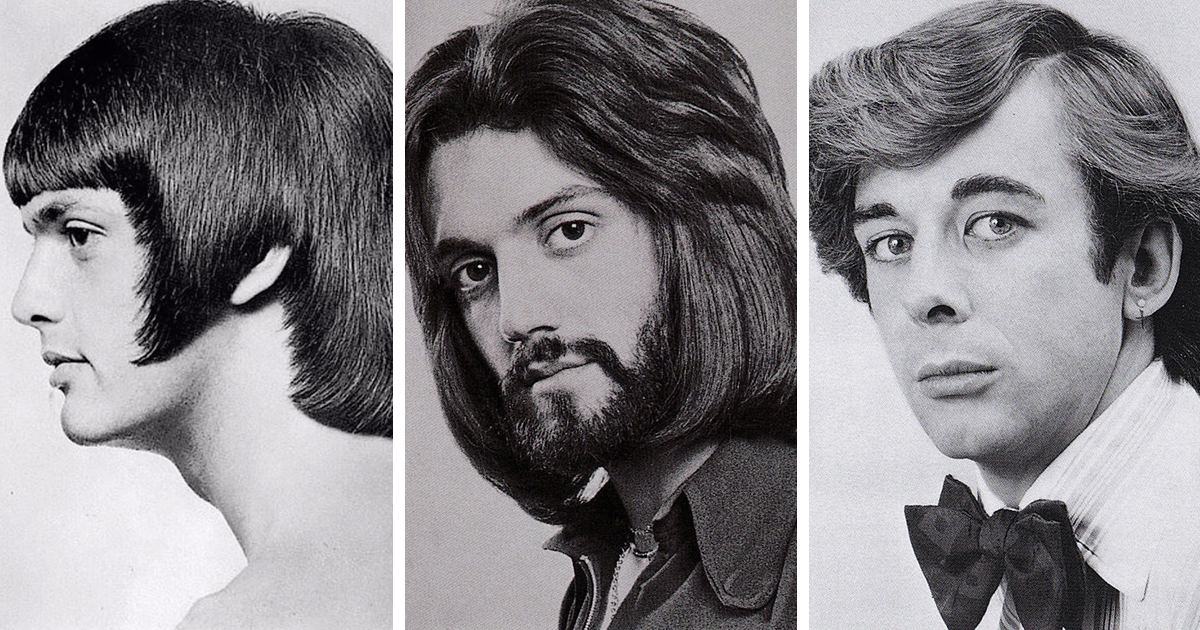
1960s Jewelry-
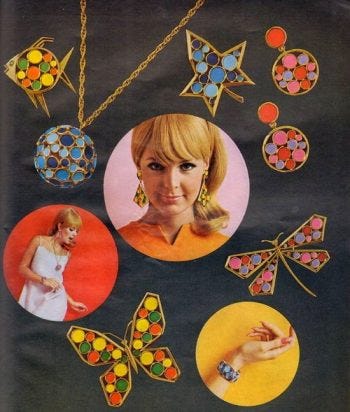
Colorful 1960s clothing needed equally colorful jewelry. In the early years, traditional jewelry continued to favor textured gold, white pastel, and colored pearls. These pretty and safe designs complimented the feminine 1950s style clothing.
During 1960s, jewellery trends inverse dramatically. At the get-go of the decade, glamour reigned supreme with glitzy, gold designs and feminine pearls. These bold accessories were influenced by popular art and featured striking designs, geometric shapes and bright colours. Key pieces included large earrings, big rings and bangles.
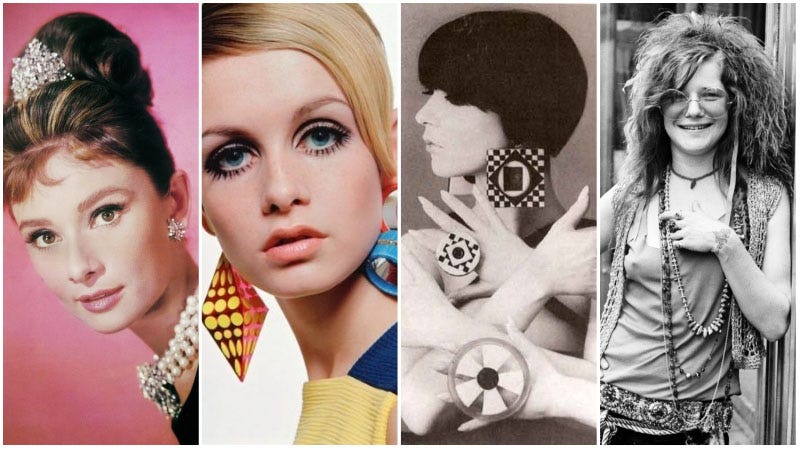
The new youth with their obsession with fake plastics, vinyl, and assuming colors favored jewelry inspired by Pop Art. Geometric shapes made their manner onto over-sized dangling earrings. Large chunky bangles or stacks of sparse bracelets jingled up and down bare artillery. Novelty shapes were yet popular, but they embraced brighter colors and more comical themes. The same went for flowers, now made from plastic resins. They were cheerful pastel or primary colored clusters hanging from necklaces, earrings and bracelets.
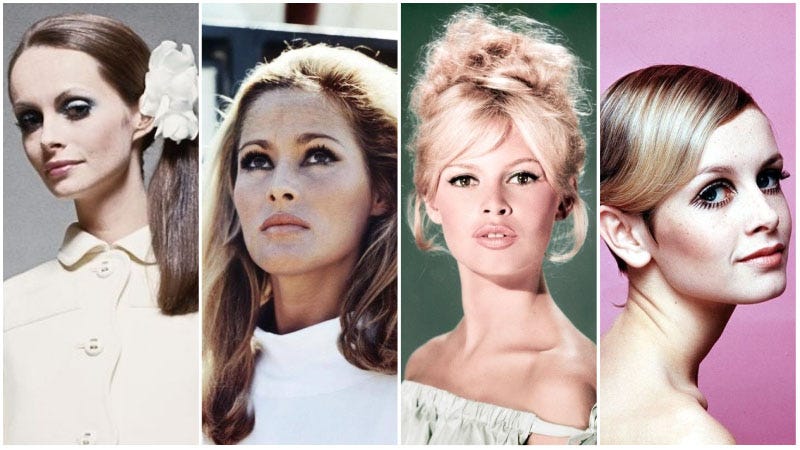
60s Makeup- Big eyes are basic elements of the archetype look from the 60'. Paired with pale lips and matte complexions, this look made way for the rather colourful habiliment. Thick, winged eyeliner was a prominent look for the decade but that wasn't the only way ladies of the '60s made their eyes pop. Long, spidery lashes à la Twiggy, eyeshadow in cool tones like bluish, and bold cut crease makeup were all too popular trends.
Pop LOOKS AND Style ICONS OF THE 1960-
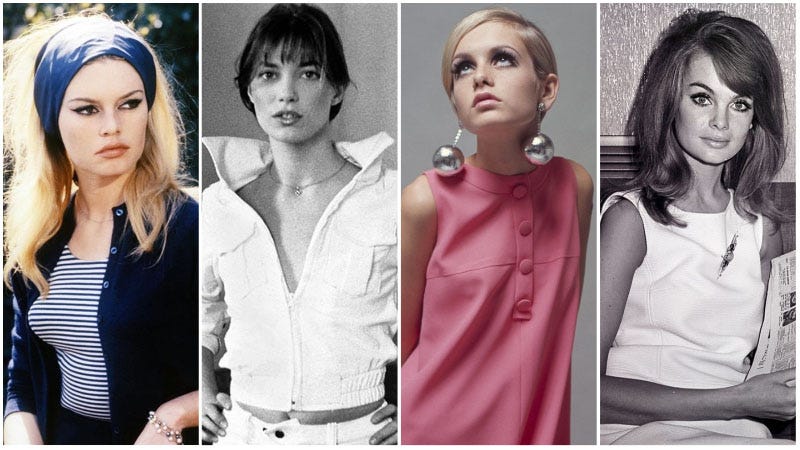
- JACKIE KENNEDY-
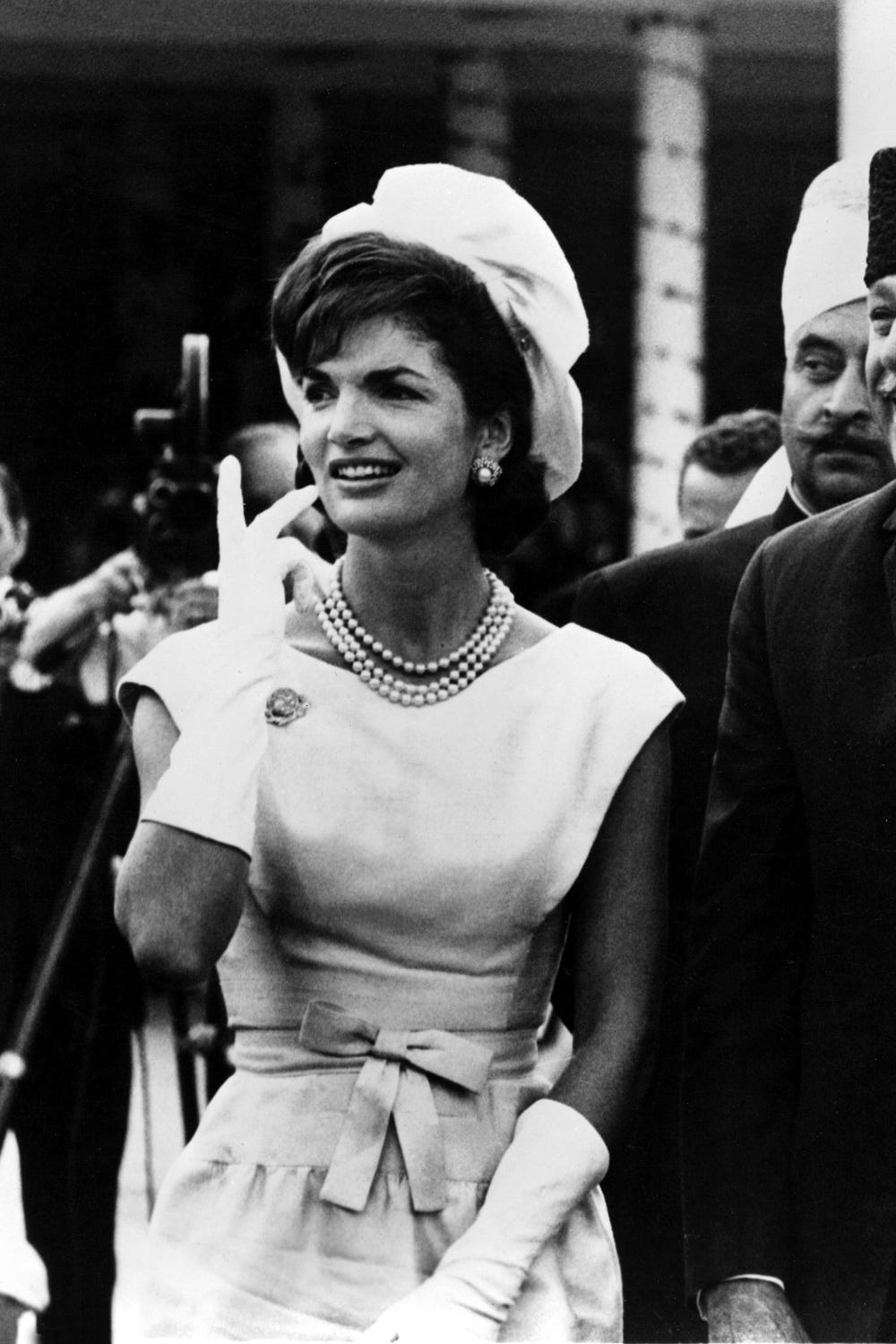
The influence was moving from name of designer to proper name of model and why not, considering the existence of models like Jackie Kennedy. Her style and fashion statement was ane of its kind as she kept it clean, simple, well fitted, with perfectly matched accessories. Her collarless dresses and single buttoned jackets made it elegantly different. Her hats complimented her sensible low heel shoes. Women in the USA and abroad accepted and copied her mode with such high enthusiasm that she became the ane who couldn't go unnoticed. Before Michelle Obama and Samantha Cameron, there was Jackie Kennedy Onassis. The original fashionable Starting time Lady managed to maintain her impeccable style throughout her time in the White Business firm, even every bit she lived through tragedy.
Jackie's prim brim suits, pillbox hats and super-sized dark glasses made her the style inspiration for women across America. The pink suit she was wearing on the 24-hour interval of her hubby'southward bump-off has gone down in history as ane of the about iconic outfits of all fourth dimension, and is a staple 1960s mode look. Jacqueline Kennedy.
In addition to the pillbox lid, women wore suits, ordinarily in pastel colors, with short boxy jackets, and over-sized buttons. Simple, geometric dresses, known as shifts, were also in style. For evening clothing, full-skirted formal gowns were worn; these often had a low decolletage and had close-fitting waists. For casual wear, Capri trousers were the manner for women and girls.
2. TWIGGY-
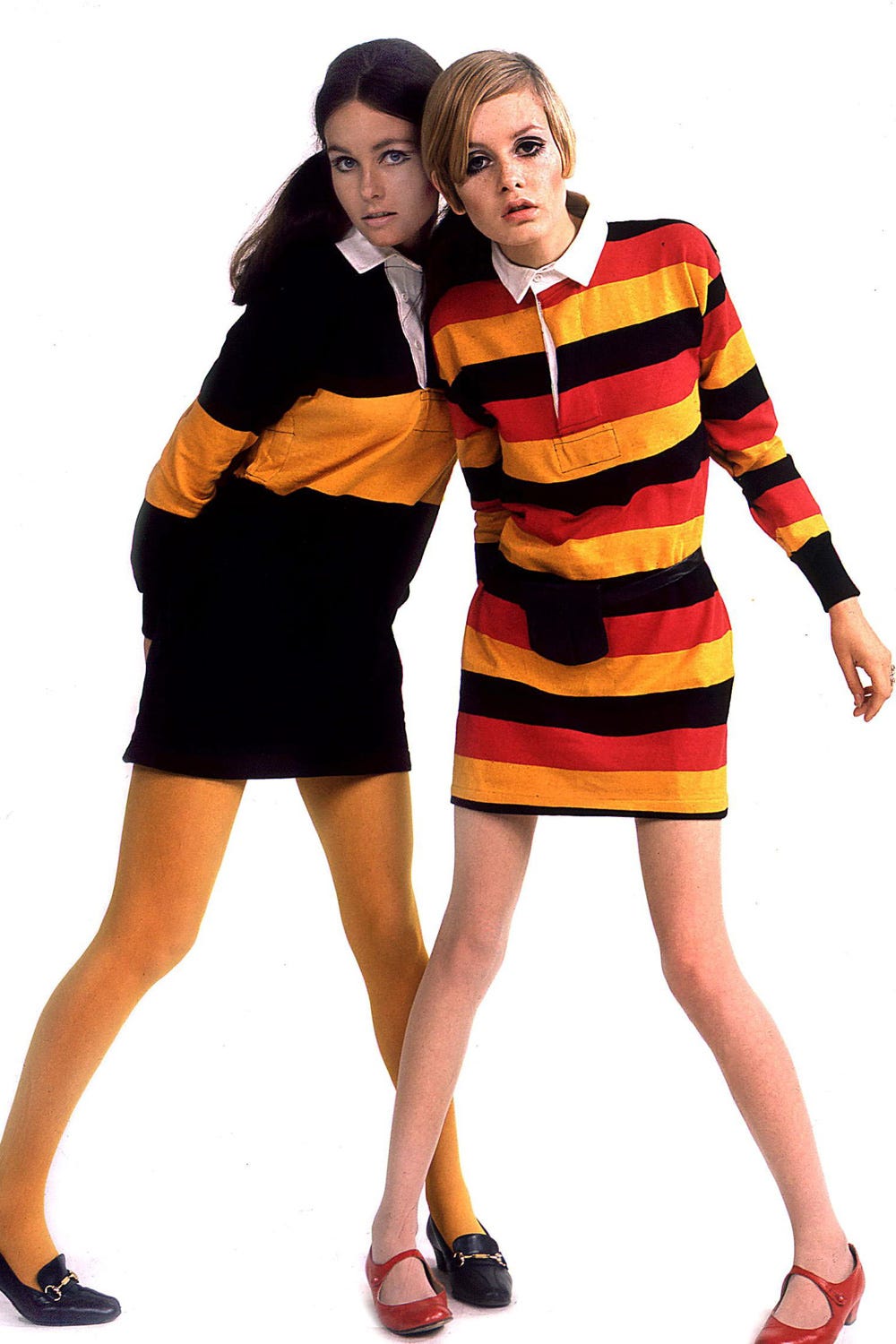
None of the 1960s fashion round-ups would be complete without mentioning Twiggy, who's real name was Lesley Hornby. Bob hairstyles were huge for 1920s mode, only this girl cemented an even short hairstyle's place in history — the pixie crop. I of the greatest muses of all fourth dimension, Twiggy quickly rose to supermodel fame, cheers to her paint 'em on thick eyelashes and the boyish style celebrity barber Leonard chopped for her in '66. Almost overnight she became the confront of the decade; instantly recognizable, she's been immortalized on everything from Andy Warhol screen prints to M&Southward shopping bags.
iii. MARY QUANT-
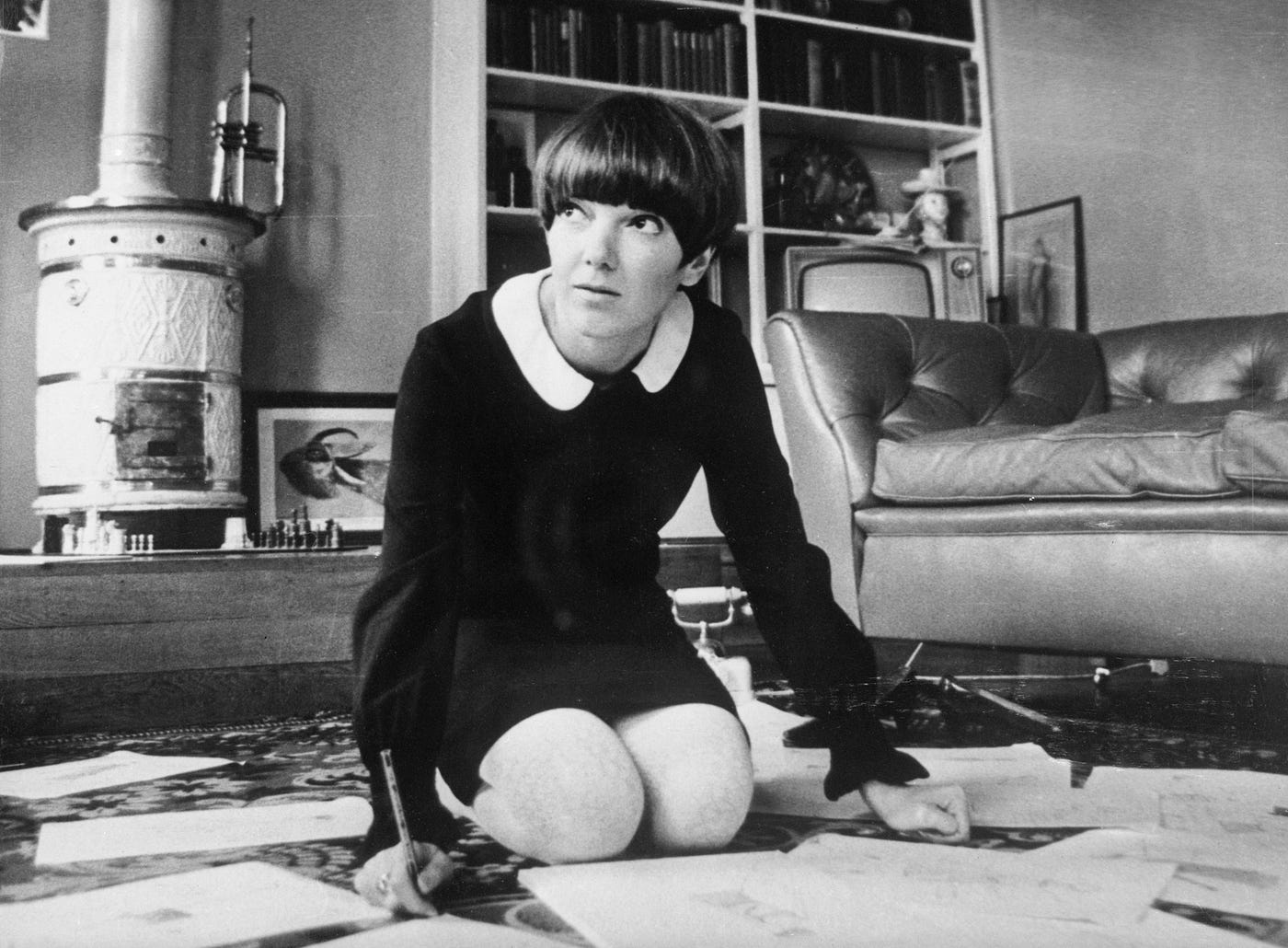
Non only was Mary Quant a 1960s mode icon in her own right, she brought the era'south greatest trends to the wardrobes of the masses from her shop on the Rex'due south Road. The mini skirt, hot pants, colored tights and plastic macs — nosotros owe them all to blueprint pioneer and epitome of sixties style, Quant.
Mary Quant was one of the greatest 1960s fashion influence. Her manner moved away from "grown-up fashion" to playful "youth" driven style. Her shift dresses were very brusk, and her prints were bold and colorful "mod" prints. Her way, her personality, set the tone for the residuum of the 1960s every bit "mode-is-fun." It was the whole idea of a return to youth that drove near of the fashion in the 1960s. Oversize collars, bows, and frail trim miniaturized women and fabricated them appear smaller.
Shapeless mini dresses emphasized a woman's natural form. Starting with designer Mary Quant who is credited with the invention of the iconic miniskirt (designed in response to the youthful, fun-loving attitude that was spreading throughout the country), the capital became known equally "Swinging London" and soon brightly colored streamlined fashions were all the rage in Europe and America . By 1966 Mary Quant was producing short waist skimming mini dresses and skirts that were ready 6 or 7 inches higher up the knee joint.
Quant plant London girls seeking newness simply too willing to try her new daring short mini skirt and the fashion tendency took off considering it was so different, and to wearable which, you had to be youthful to get abroad with an outfit that was so controversial, specially among adults. The Quant manner was presently known as the Chelsea Await. The shapes Quant designed were simple, peachy, clean cut and young. They were fabricated from cotton gabardines and adventurous materials similar PVC used in rain Macs. They almost e'er featured little white girly collars. Truly the designer of her time.
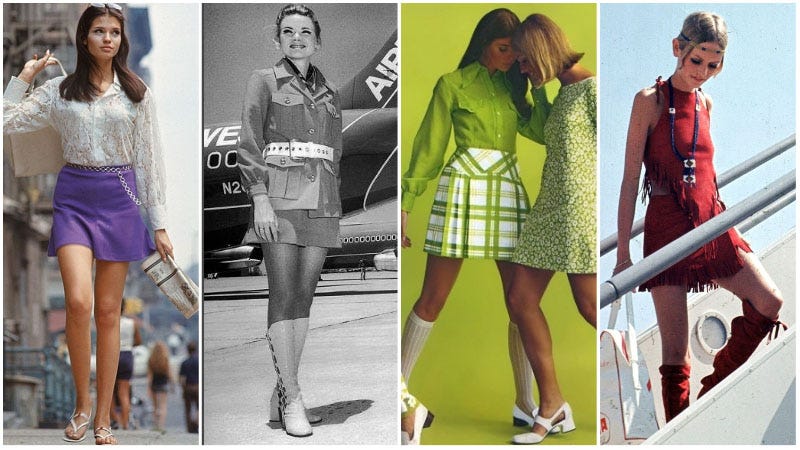
iv. THE SINGLE GIRL Expect- The second-wave of feminism was getting its outset during this period: pushing for a new feminine ideal to be capitalized on. Writer, Helen Gurley Chocolate-brown, wrote Sex and the Single Girl in 1962. This book acted as a guide for women of whatsoever marital status to have command of their ain lives financially as well as emotionally. This book was revolutionary since information technology encouraged sexual activity before wedlock; something that was historically looked downwards upon. With the loftier success of this book, a pathway was gear up for media to likewise encourage this behavior. Manner photography in the 1960s represented a new feminine ideal for women and young girls: the Single Girl. 1960s photography was in sharp contrast to the models of the 1920s, who were carefully posed for the photographic camera and portrayed as immobile. The Single Girl represented 'movement'. She was young, unmarried, active, and economically cocky-sufficient.
This platonic- single girl needed to be significantly bold, independent and most of all professional person. These elements were a highlight of this look as models and photographers came together to shoot in a story telling mode. They fabricated models walk in the outdoors representing the latter. Models in the 1960s also promoted sports wearable, which reflected the modernistic fascination with speed and the quickening pace of the 1960s urban life. This direct implemented the idea a common market place. Women from all economical groups could be seen shopping nether the same roof.
5. VERUSCHKA- Shot by Avedon, Irving Penn and Helmut Newton, Veruschka is the splashy High german model who landed her starting time major magazine encompass in 1963. All legs, eyes and lips, she exuded sex appeal and pb style in a new direction for 1960s fashion, past pioneering a new 'skinny chic' ideal.



half dozen. BABYDOLL Look- "Baby doll dresses of 1966 were full and flared into tent shapes mostly with cutaway armholes or/and a halter neck. They were made of transparent tulles, lace or chiffons plain or tree bark mounted over a matching lining or could be made of crinkled cotton crepe fabrics. Lace of all types from Broderie Anglaise to Guipure to with crocheted furnishings over colored linings or mankind toned linings were oftentimes seen. Black polo neck sweaters made popular by the Beatles comprehend album were often worn nether check pinafore dresses. The dresses were usually solid colors of red or imperial wool material. Black and white was a sixties combination and was used in art dresses and block pieced dresses worked in Mondrian fashion. Black patent accessories complimented all these combinations. Ane of the easiest means to become the sixties look was to wear short little colored gloves with a pigsty cut out to reveal the back of the mitt."

These elements non simply ascertain a wait but also suggest in all places the resemblance to majorly all famous styles that accept been mentioned in this article. The wait, thus, is an overall representation of a decade equally a whole.
Swimwear, peculiarly the bikini became smaller than 1's seen before. This was so revolutionized by a German language designer- Gernreich who allegedly designed as a symbol of women's liberation — as he himself stated, "…in mode, also as every other facet of life." The topless swimsuit would soon atomic number 82 to the topless dress, and also give nativity to another revolution, the 'no-bra bra' which would bring upon quite a modify to the fit of dress and was somewhat more than adequate in public. Although the mini dominated for the most of the decade, women sometimes needed a applied culling smarter than jeans that could exist worn day or evening. Quite formal trousers worn with a tunic, shirt, skinny rib or matching suit jacket were acceptable in certain work situations and liked as alternative evening wear when made from slinkier materials. Trousers were fabricated from Courtelle jersey, cotton wool velvet, silky or bulked textured Crimplenes, lace with satin, and Pucci style printed Tricel.The '60s as well gave nascency to the skinny jeans, worn by Audrey Hepburn, which again became popular with young men and women in the outset decade of the 2000s. The belatedly 1960s produced a style categorized of people who promoted sexual liberation and favored a type of politics reflecting "peace, love and freedom."
vii. AUDREY HEBURN-
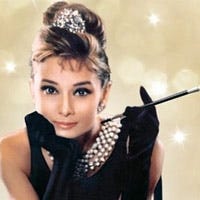
Bringing back a blueprint that was long forgotten is the art of a true fashion fable. Audrey did the same when she brought back the picayune blackness dress on the way map afterwards her appearance of the aforementioned in the 1961 Breakfast at Tiffany's. The next to follow was the top handle bag and picture show star shades. At that place was goose egg she would put on that didn't get for a home run. Costumes dominated evening wear, consummate with matching jacket or wrap. Later in the season the long, tweed dinner coat was showcased in several high-fashion collections. 1962 more often than not focused on 3 styles:
1.) Sleek and slender
ii.) softly bloused with muffled neckline
3.) "natural" outline, which vicious in a unproblematic, form-fitting line
Greater choices allowed women to express their individuality.
eight. Late 1960s Fashion: The Hippie Look-

Anti fashion, as the proper noun suggests is the opposite of the trends accustomed by the fashion earth. In the case of belatedly threescore's, the term Anti fashion couldn't perchance define the hippie culture as it became a manner manner in itself. Where opposites had already existed in the early and mid 1960's the end was yet another. This expect starred the faded denim jeans, basic and boring t-shirts, The flower child decorated patches, painting and studding etc. A strapless undershirt and denims were the major highlights. Woods green with dark-brown suede, sunshine yellow with denim blue were signature colors of the hippie '60s.
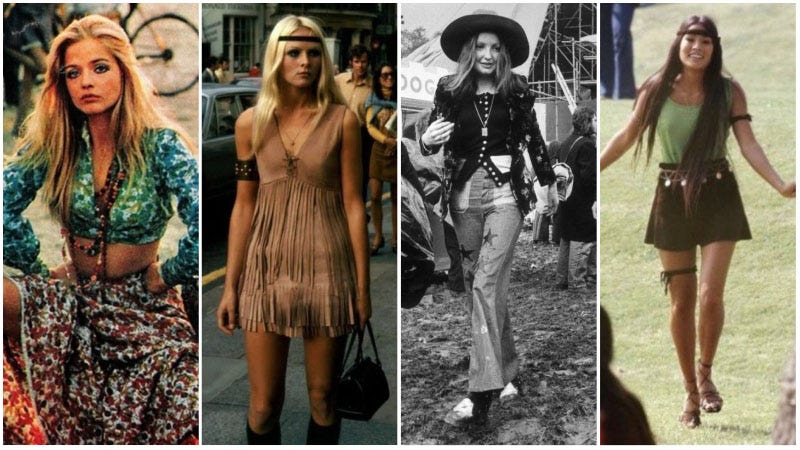
9. Modern Way- As London was the epicentre of this period'due south fashion trends, the Modern Fashion that started in London in 50's, spread around the earth throughout the lx'south. Widely known equally the "London Look," it made an enduring impression that lasts till date. It mainly revolved around modern designs, bright colours, and raised hemlines and thus remains a youth favourite.
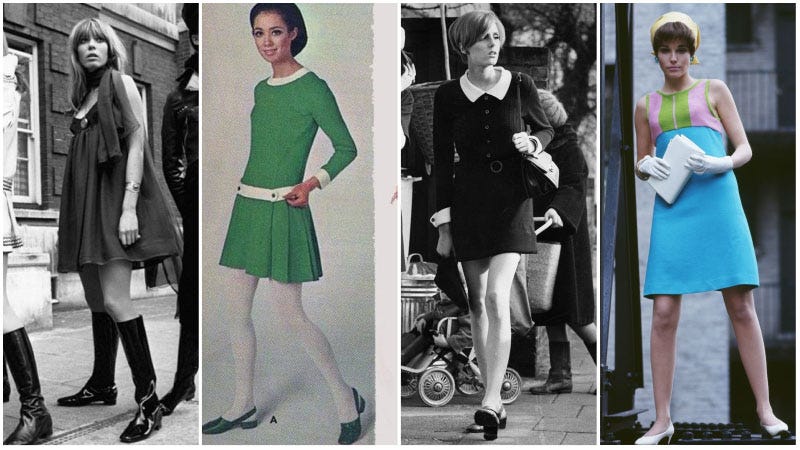
x. Crackpot Fashion- Young individuals followed the likes of of 1950's every bit they were not yet ready to get over the arts, literature, poetry, jazz music etc. This kept the Beatnik or the beat out generation alive until mid 1960's. Their unofficial uniform consisted of blackness turtlenecks and trousers, berets, and striped tops amid other items.
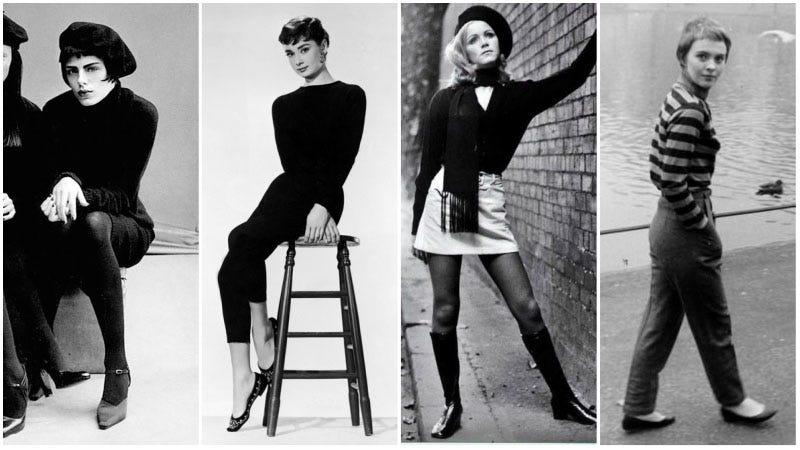
1960s Mode can be summarised as-
- Jackie Kennedy, Brigitte Bardot, Mary Quant were style icons
- The Youthquake movement created "Babydoll" clothing
- Short, shapeless shift dresses in pastels or bright colors
- Button down shirts, turtlenecks, chunky knit sweaters
- Mini skirts or pencil skirts in plaid
- Jax pants, stirrup pants, bell bottoms, pantsuits
- Depression heels flats, boots and shoes made of vinyl
- Stockings or tall socks in all colors
- Pop Art Jewelry
- Short bobbed hair or long straight hairstyles
This summary tin can be used to conclude a definition for the 1960's fashion every bit- The decade of coexistence of contrary trends that were set by role models.
Bibliography-
Images for 1960s women's way
Co-ordinate to victorxenialondon.com
1960s Manner for Women & Girls | Styles, Trends & Photos — RetroWastehttps://world wide web.retrowaste.com/1960s/fashion-in-the-1960s/1960s-fashion-women-girls/
1960s Fashion Icons: Meet 25 Women Who Shaped The Swinging …https://www.victorxenialondon.com/1960s-style-icons-meet-25-women-shaped-swi...
Take a Look at These 1960s Fashion Icons | Who What Wearhttps://www.whowhatwear.com/it-girls-1960s-style
2481 best 1960s Fashion images on Pinterest in 2018 | Vintage …https://in.pinterest.com/vintagedancer/1960s-style/
1960s Fashion — Styles that trended in the 1960s — FiftiesWebhttps://fiftiesweb.com › Mode
Images for 1960s hippie mode
1960s Hippie Fashion — Women'southward Mode — LoveToKnowhttps://womens-mode.lovetoknow.com › … › Style Tips for Women
Hippie Style — Fashion History | LoveToKnowhttps://style-history.lovetoknow.com › Way History and Eras
1960s Fashion: What Did Women Article of clothing? — Vintage Dancerhttps://vintagedancer.com/1960s/1960s-fashion-womens/
60'south Costumes, 60s Outfits, 60s costumes, 60s Fashion,60's … — Funwirkshttps://www.funwirks.com › Decades › threescore's Costumes
0 Response to "What Happened to Fashion in the 1960s?"
Post a Comment